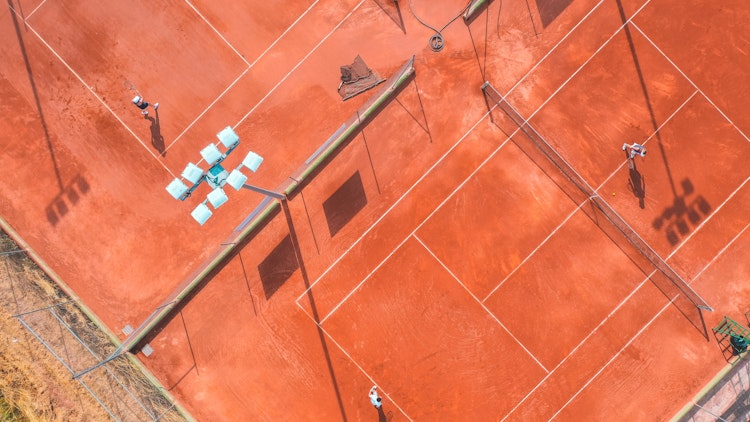The Roland Garros Women’s Tournament Is A Tale Of Two Cities In Paris
Last updated: May 28, 2021, 1:40AM | Published: May 27, 2021, 8:11PM
It was the best of times, it was the worst of times.
That’s what players on the WTA Tour are thinking as they prepare for the women’s French Open.
Full disclosure: I knew what I wanted to write about the men’s tournament – a piece on Dominic Thiem– as soon as Stats Insider gave me an assignment.
As for the women’s tournament, I wanted to wait to see what the draw offered. I like to say that “draws shape stories,” meaning that certain realities are made possible – and impossible – by the draw.
For instance, Rafael Nadal and Novak Djokovic can’t play in the men’s final. They were drawn in the same half, meaning that if they meet, it will be in the semifinals. This means a non-Big-3 player will make the final from the other half of the draw.
In the women’s French Open, the draw also shaped a lot of stories.
We won’t have a blockbuster final between former French Open champions, because the former French Open champions with a real chance to make a run to the title are all in the top half!
Ashleigh Barty, Garbine Muguruza, and Iga Swiatek – three of the top contenders at this French Open – are all in the top half. Serena Williams is a former French Open champion, but she is not expected to go deep in Paris, and she's in the bottom half of the draw. Simona Halep is injured and out of the tournament. Jelena Ostapenko, the 2017 champion, is a dark horse but also in the top half.
Among the players who aren’t former French Open champions, but who have the ability to go all the way in France and win a first major title, many of them are also in that loaded top half. Maria Sakkari is there. Elise Mertenstoo. Elina Svitolina is also there. Australian Open semifinalist Karolina Muchova is there, as too is Jennifer Brady, who ousted Muchova at the Australian Open to reach her first major final.
The top half of the draw is impossible to predict because so many top-tier players and dangerous contenders reside in that 64-player grouping.
Consider the amazing third- or fourth-round matchups we could have in the top half, if top players avoid early-round upsets:
- Coco Gauff-Jennifer Brady in the third round
- The Gauff-Brady winner vs. Barty in the fourth round
- Muchova-Svitolina in the fourth round
- Sakkari-Mertens in the third round
- The Sakkari-Mertens winner vs. Sofia Kenin or Ostapenko in the fourth round
- Muguruza-Swiatek in the fourth round, possibly the match of the tournament
RELATED: Why Is It So Ridiculously Hard To Win On Clay?
The top half is a possible banquet table of massive matchups if players escape the first two rounds unscathed. Try picking a winner from that group.
That is one of the “two cities” in this Roland Garros women’s draw.
The other city – the other 64-player grouping – feels like an entirely separate universe.
The bottom half of the women’s Roland Garros draw contains big names, but not players who are in form at the moment.
Serena is there. Petra Kvitova is there. Naomi Osaka, who plainly admits she is not ready to do well on clay at this stage of her impressive career, is also there.
Angelique Kerber and Victoria Azarenka are there. Bianca Andreescu, who had to pull out of her Roland Garros warm-up tournament with a slight abdominal tear, is in this half as well.
Kiki Bertens, a former French Open semifinalist, has not done much of anything on tour this year, but she is in this half, too. Former French Open semifinalist Jo Konta is in this half.
It’s a collection of players who have done well in the past, but either aren’t playing great or lack ideal fitness (or both).
The women’s draw at the 2021 French Open really did create two entirely different cities, two worlds in which predicting a winner is extremely difficult… but for diametrically different reasons. In the top half, nearly all the elite contenders and dangerous floaters exist. In the bottom half, there are plenty of recognisable faces, but very few who are playing well and are fit enough to inspire confidence.
The one player who stands out from the crowd in the bottom half of the draw is – by far – Aryna Sabalenka. Seeded third, she doesn’t have Barty, Swiatek, Muguruza, Svitolina, Muchova, Sakkari, or Mertens to worry about. She received the half of the draw with Osaka, an ideal outcome at the French Open (as opposed to the Australian or U.S. Opens. She is in the same section as Azarenka, who has been hit hard by injuries after reaching the 2020 U.S. Open final, where she lost to Osaka.
Sabalenka is a better hardcourt player than a clay-court player, but she took advantage of Madrid’s hitter-friendly conditions to win that 1,000-point tournament. She's battle-tested and has been given the best major-tournament draw of her young career. The Belarusian has never made a major quarterfinal, let alone a final. This is her clear golden chance to post an excellent result at a major. How she handles the pressure will be a central tournament storyline….. made possible by this draw.
RELATED: Examining the Stats Insider's Tennis World Rankings Before Roland Garros
It was the best of times, it was the worst of times.
If you are a WTA player in the bottom half of the draw, it is the best of times, because so many elite and dangerous players are not in your path to the final. This is a vast and verdant field of opportunity and possibility. Talented and credentialed players exist in this half of the draw, but they have either been hit by injury, or are rusty – as Serena Williams is – or are struggling with confidence, as is the case with Angelique Kerber, a three-time major champion in search of one more big push in the latter stages of her career.
If you are a WTA player in the top half of the draw, it is the worst of times, because that half of the draw is a minefield of ferocious matchups and immensely difficult challenges. The first two rounds for players in the top half of this draw might be relatively comfortable, but there will not be a chance to “ease into the tournament” in the third and fourth rounds. This tournament is likely to explode on the first weekend in Paris. So many players who are capable of making a semifinal or final might have to face each other in the Round of 32 or the Round of 16.
In particular, the possibility of Muguruza – the 2016 Roland Garros champion – playing Swiatek, the defending champion from last October, in the Round of 16 is crazy. It evokes an obvious comparison to this year’s Australian Open, in which Muguruza’s Round of 16 match against Naomi Osaka felt like a final and played like a final… and had the impact and significance of a final, given that Osaka was never seriously threatened in Melbourne after she saved two match points to escape with a dramatic victory.
Muguruza-Swiatek, if that matchup occurs in Paris, will feel like a far more significant occasion than a Round of 16… and yet, that’s what the drawsheet says it is.
Conversely, we might have multiple quarterfinals and a semifinal in the bottom half of the draw which do feel like Round of 16 matches.
It really is a tale of two cities at the 2021 women’s French Open. Both halves will feature cutthroat competition, but the top half consists of the ruling class locked in a dramatic power struggle, while the bottom half consists of the working class trying to mount a revolution and emerge from comparative obscurity to shake things up.
I have no idea who will win the women’s French Open, but the draw certainly shaped storylines and readjusted our sense of what is possible, especially for Aryna Sabalenka.
This tournament is taking place in one city – Paris – but two smaller cities exist within the City of Light’s magnificent expanse.
Did you enjoy this article? Join our free mailing list to get the best content delivered straight to your inbox, or join the conversation by leaving a comment below or on the Stats Insider Twitter or Facebook page.



